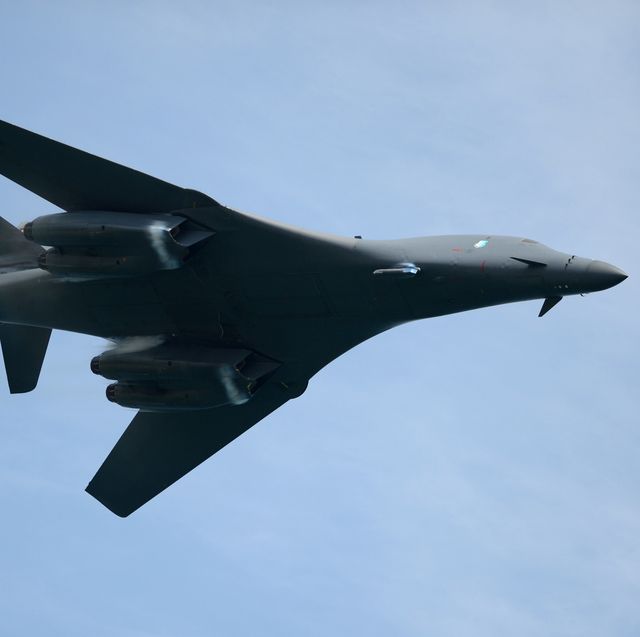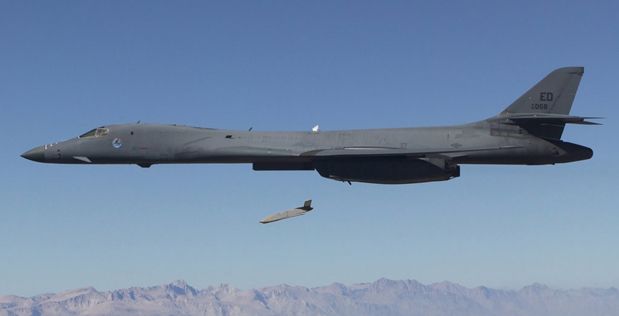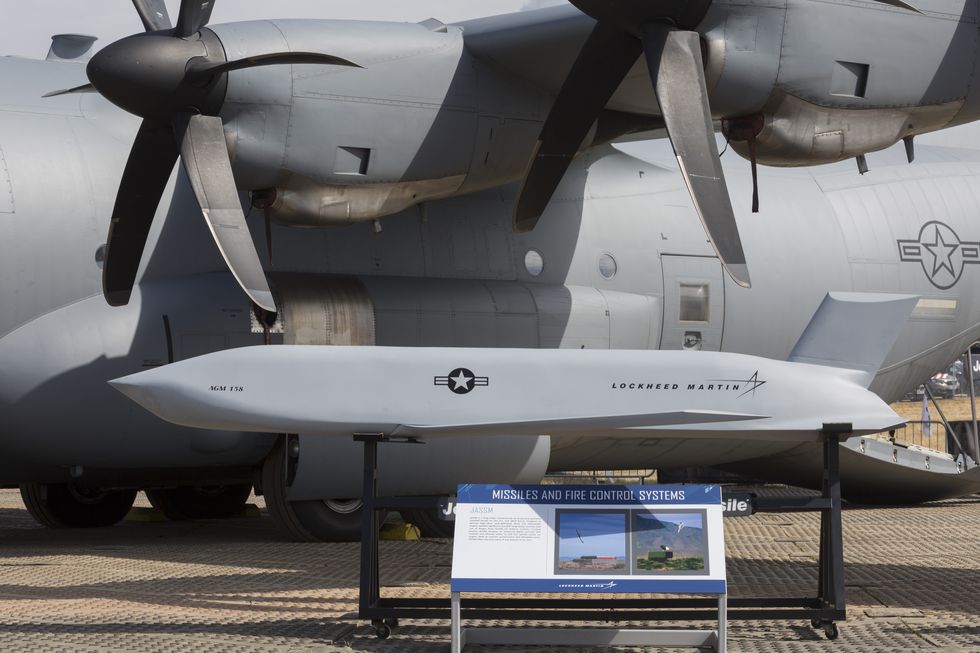- The U.S. Air Force is pushing to arm the B-1 bomber with dozens of stealthy cruise missiles.
- It could carry as many as 36 anti-ship or land-attack cruise missiles.
- The sheer amount of firepower could allow a handful of bombers to sink an entire Chinese carrier battle group.
The Air Force is on the verge of turning the B-1 bomber into a flying arsenal, busting enemy ships and land targets with dozens of anti-ship and land-attack missiles. The aircraft could soon carry as many as 36 cruise missiles, granting it a level of firepower approaching that of an aircraft carrier. The sheer number of missiles carried by each bomber would make it a formidable threat—and the most dangerous version of the B-1 yet.
Load ‘Em Up
The Air Force is working to increase the number of Long-Range Anti-Ship Missiles (LRASM) and Joint Air-to-Surface Standoff Missiles (JASSM) a B-1 Lancer bomber can carry, according to Business Insider. Having mastered the ability to load the bomber internally with up to 24 missiles, the service is now developing the means to externally carry an additional 12 missiles for a total of 36.
The JASSM and LRASM missiles are cousins. JASSM was developed in the 2000s as a stealthy, subsonic cruise missile. JASSM typically uses GPS to fly to a midpoint, then uses an imaging infrared seeker and pattern recognition system to identify the target. Once identified, JASSM bores in for the kill, exploding its 1,000-pound high-explosive warhead. The warhead can be programmed to airburst the target, showering the ground below with shrapnel, or dive into the target and penetrate hardened targets such as bunkers or other protective defenses.
LRASM was designed as a replacement for the aging Harpoon anti-ship missile. LRASM was developed from the extended-range version of JASSM, JASSM-ER. From the outside, the two appear very similar, but LRASM incorporates satellite data link targeting—the ability to detect and then fly around enemy air defenses, and ship target recognition to ensure it homes in on the correct target. Here’s a video from Lockheed Martin explaining how LRASM does its thing:
Arsenal Plane
The push to load the B-1 with as many missiles as possible goes back to the Arsenal Plane concept, an idea from the late 2010s that sought to stuff a large aircraft to the gills with missiles. This would help leverage the U.S. military’s large number of aircraft in wartime—even transport aircraft—to deliver as many missiles as possible.
One outgrowth of the Arsenal Plane concept was Rapid Dragon, a palletized missile delivery system. But it also prodded the Air Force into making the most out of existing planes. The B-1 Lancer bomber, for example, was a low-level penetrating bomber designed to deliver thermonuclear weapons on targets deep in Soviet territory. Cut loose from the nuclear mission, the bomber has languished—even used as a fast, if very expensive, close air support aircraft in Afghanistan.
The average age of a B-1 bomber is 34.5 years, and the entire fleet is set to be retired in the early 2030s as the B-21 Raider starts entering service. But lacking the ability to carry weapons externally, the Raider won’t be able to deliver as many missiles as the B-1 can. While the B-1 is difficult to maintain as the aircraft ages, the ability to load up a small number of bombers with a huge number of missiles means just ten bombers could carry up to 360 missiles into battle.
A One Aircraft Sink Fest
During the Cold War, the B-52 bomber could carry up to 12 Harpoon missiles in the anti-ship role. An F/A-18E/F Super Hornet can carry as many as two LRASMs, and a P-8 Poseidon maritime patrol aircraft might be able to carry as many as six LRASMs. The B-1/LRASM combo promises an unprecedented amount of anti-ship firepower.
The Navy worried constantly about the threat from Soviet Tu-22 “Backfire” bombers during the Cold War, because each could carry a pair of AS-4 “Kitchen” anti-ship missiles. In a conventional war, a U.S. carrier battle group could face scores of AS-4 missiles launched by dozens of bombers. The U.S. Navy was so concerned about the threat, it developed the Aegis Combat System, including the SPY-1 phased array radar, to defend against mass missile attacks, and the F-14 Tomcat air superiority fighter armed with the AIM-54 Phoenix long-range missile.
Now, 50 years later, the Chinese Navy faces an even greater threat: as few as five B-1 bombers could launch as many as 180 LRASM missiles at a Chinese carrier task force. In a scenario pitting five such bombers against one Fujian-type aircraft carrier, four Type-055 and 052D destroyer escorts, and a Type-054A frigate, it’s likely all six would quickly become scrap on the bottom of the Pacific Ocean. Even if the Chinese fleet managed to shoot down 95 percent of the missiles (for the sake of our argument, 30 percent is generous), nine would get through, visually home in on the carrier, and turn it into a flaming wreck.
The Takeaway
If the Air Force is successful in plastering the outside of its B-1 bombers with missiles, it could, for a brief moment, have one of the most powerful non-nuclear weapon system combinations in history. Just five aircraft with a total crew of 15 could quite conceivably sink six warships with a total crew of over 3,000. That’s a ratio hard to achieve without the use of nuclear weapons. If the Air Force can achieve it, mismatches like this could help avoid a war—and stop it before it starts.

Kyle Mizokami is a writer on defense and security issues and has been at Popular Mechanics since 2015. If it involves explosions or projectiles, he's generally in favor of it. Kyle’s articles have appeared at The Daily Beast, U.S. Naval Institute News, The Diplomat, Foreign Policy, Combat Aircraft Monthly, VICE News, and others. He lives in San Francisco.
















